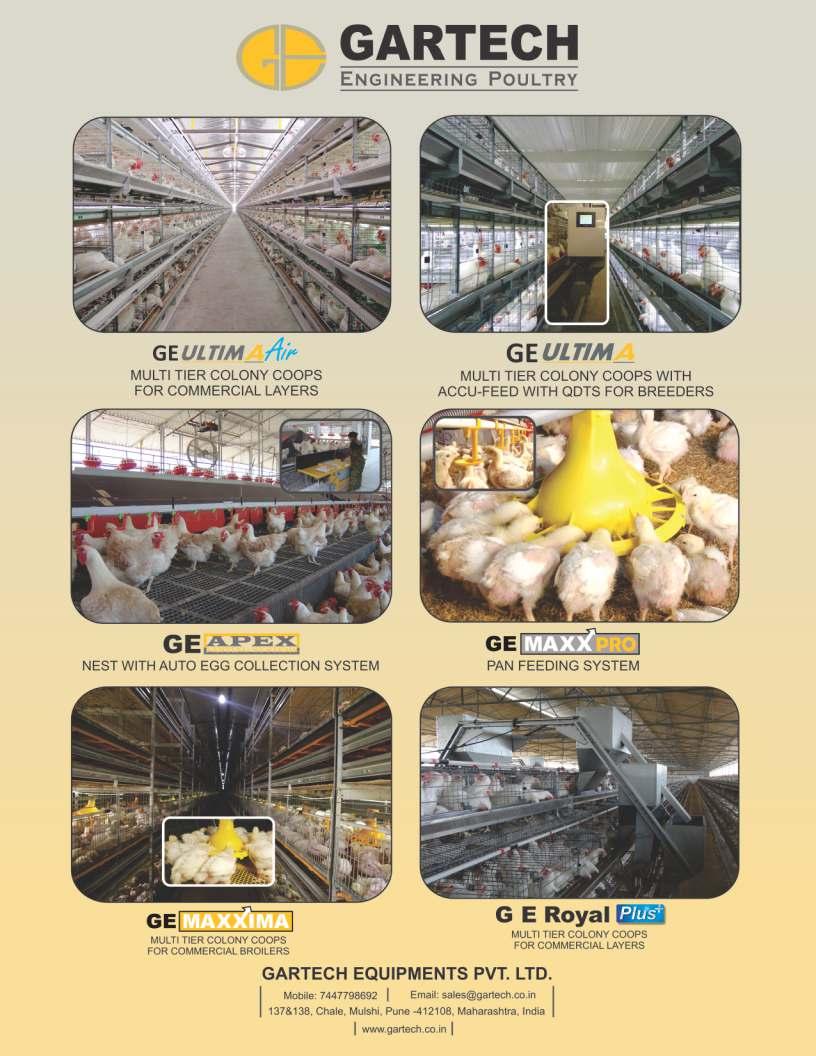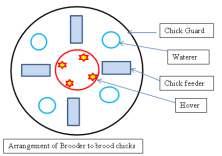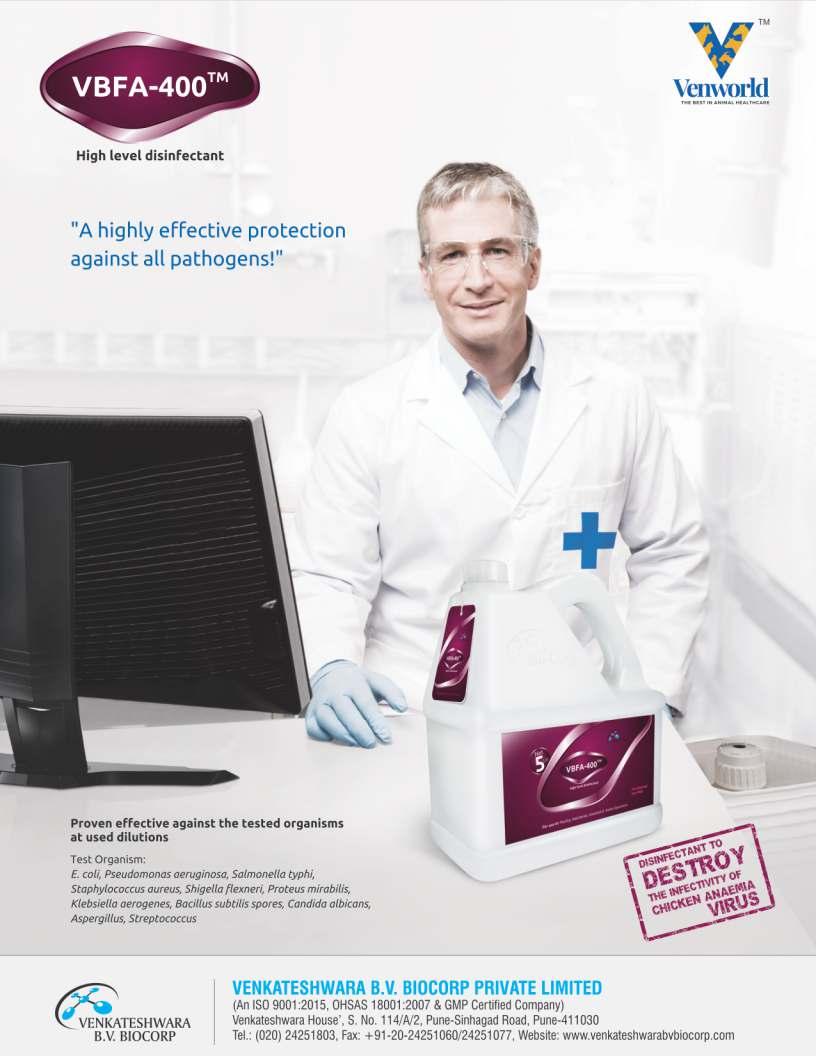
12 minute read
Brooding Management in Commercial Broilers
1Zulfqarul Haq , Azmat Alam Khan1, Nazir Ahmed2 1 and M. Iqbal Yatoo .
1Division of Livestock Production and Management, F.V. Sc & AH, Shuhama
Advertisement
2 Directorate of Extension,Shalimar, SKUAST-Kashmir. Sher-e-Kashmir University of Agricultural Sciences and Technology of Kashmir, India
Introduction
Brooding is a period immediately after the hatch when special care and attention is given to chicks to support their health and survival. A recently hatched chick has not yet developed theirownmechanismtoregulateitsown body temperature hence, it cannot maintain its body temperature properly for the first weeks and it is subject to chilling in the winter season when extra heat is not provided from externally. Brooding is an art and science of rearing large number of baby chicks in the absence of a broody hen. A newly hatched chick has not developed the thermoregulatory mechanism fully and takes about two weeks to develop this mechanism and homeostasis. Therefore, they cannot maintain the body temperature properly for the first few weeks of life and may be subjected to chilling, if not properly taken care of. Hence, artificial brooding is mainly aimed at, providing the right temperature to the chicks. In addition to the temperature, adequate floor, feeder space, water space, relative humidity, ventilation and light should be provided for optimum comfort and growth of the chicks.
Classification of brooding
Brooding is classified into natural and artificial brooding. Natural brooding is done with the help of broody hens after hatching, up to 3 to 4 weeks of age. In artificial brooding large number of baby chicks are reared in the absence of broody hen. Equipments used for brooding are called brooders. Brooder comprisesofthreeelements:
1. Heating source 2. Reflectors 3. Brooder guard
Heating source may be electrical, gases like natural gas, LPG and methane, liquid fuel like kerosene, solid fuel like coal, wood can be used as a heating material
Types of brooders
The primary object for brooding is to provide the right temperature especially the temperature to the growing chicks. The different types of heat to the baby chicks will be following. I) Incandescent bulbs and other types of bulbs ii) Heater coil with thermostat iii) Gas brooder iv) Kerosene stove v) Charcoal stove vi) Centralized heating system vii) Battery brooder viii) Biogas brooder
i) Bulb type brooder
Different types of electrical bulbs, which will generate heat besides light will use. The most commonly used bulbs for brooding will be 100-200 watts incandescent bulbs. One to two watts capacity is used for each chick, depending on the outside temperature. Incandescent bulbs will burn out soon and has to be replaced periodically. Moreover, it needs higher electricity and may not be economical in places where the electricity charges are higher. Certain farmers use infra-red bulbs, spot lights, reflector bulbs and focus bulbs; which will generate more heat than incandescent bulbs. Even though these bulbs are costlier, they are economical on a longer run, due to their durability and lesser power consumption.
ii) Heater coils
Heater coils of various watts capacities with thermostats reflector hoods and hanging chain are available for providing heat to chicks. These coils are more suitable for cold climates, because they give more heat. Separate tube lights have to be provided for lighting the house.
iii) Gas brooder
In places where natural gases or liquefied petroleum gas is available at a cheaper rate and reliably, gas brooding can be practiced. With the help of a regulator or central control unit, the heat intensity can be regulated.
iv) Kerosene stove brooding
Kerosene stove can be used to warm up the brooder houses. To dissipate the heat uniformly into the brooder house, a metal vessel or plate filled with sand or water may be place over the stove. This is suitable in places, where electricity failure is quite often.
v) Coal or charcoal brooding
Instead of kerosene, coal, charcoal or lignite can be used as fuel for stoves. These stoves will not only gives better heat, but also found to be cheaper. Hence, it is more common in rural areas, where power failure is too frequent.
vi) Centralized heating system
This system of brooding is followed in environmentally controlled poultry houses; where the room temperature is maintained at an average of 32°C during first week of age. This temperature will be gradually reduced
by 2-3°C every month until the room temperature or 18-20°C temperature is reached.
vii) Battery brooder
Multi-tier cage brooding is practiced here. Bulbs or heaters with thermostats are used to provide warmth to chicks in the battery cages.
viii) Bio-gas brooders
Certain forms will use the cage droppings and cow dungs to generate bio gas; which will be used to provide light and heat to the birds. Specially designed gas heater mantles are used to generate heat; which will be reflected towards the chicks; with the help of a polished metal reflector.
Preparation of shed to receive the chicks
After cleaning, washing and disinfecting the brooder house, close it until the arrival of chicks. Even the open sided may be closed with gunny to avoid dust and chillness to chicks.
Brooder arrangement
About 24 hours prior to the arrival of chicks, spread the litter material like rice husk, paddy husk, ground nut hulls, coir pith, sugarcane baggage, wood shavings, saw dusts, paper spreads etc. depending on the cost and local availability to about 5 cm (2 inch) thickness.Spread old newspaper over the litter to prevent baby chicks from eating the litter. Arrange the chick guards made up of either hard board or galvanized steel (iron) of about 40-45 cm height, in a circular fashion. The diameter of the brooder space varies from 1 to 2.5 meters depending on the number of chicks to be brooded. The height of the brooders or hovers shall be about one foot above the litter level at the start, slowly increase the height and remove the brooders, when the chicks are around 1-3 weeks of age, depending on the room temperature. The heat source may be canopy type h o v e r b r o o d e r s h a v i n g 2 - 5 incandescent, infra red bulbs (60250watt capacity) with individual on-off switch for the bulbs to provide the right temperature. If incandescent bulbs are used, they will supply the required light also. Some brooders have heating elements with thermostats mechanism to regulate the temperature. If heating elements, coils or stove are used for heating, then incandescent or fluorescence lights have to be provided for the purpose of light. Recently brooder stove cum blowers are used which will gently blow hot air over the chicks reared under limited area brooding. Considerable saving in the fuel/electricity cost is claimed under this system. In battery (cage type) brooders, heating mantle coil or incandescent/infra-red bulbs are used for providing warmth to the chicks. The feeders and waterers under the brooders have to be arranged alternatively in a “cart-wheel spoke” like fashion. For baby chicks, during their first few weeks of life, feed may be given in shallow trays, chick box lids, card board box lids or even in new (or sanitized) egg filler flats, to encourage eating of feeds and discourage eating of litter. There should be free moving space all around the feeders and waterers; so that the feeders and waterers spaces will be fully utilized. Provide three 60-70 cm linear chick feeders and two chick waterers for each 100 baby chicks. Under cage (battery) brooding system, old newspaper, gunny or corrugated sheet may be spread over the cage floor. Initially, the feeders and waterers may be fixed inside the cages and later shift them outside to provide more space to the growing chicks. Before the arrival of chicks, check the whether the bulbs, heating system, automatic feeders and waterers are working properly. In case of cold climate switch on the heaters or bulbs 1 or 2 hours before arrival of chicks, so that the room temperature reaches 35°C.
Brooder management
Proper brooder management consists of maintaining the correct temperature, light, ventilation, space, feeding, watering etc. Of these, the temperature is the most important criterion. For knowing the correct temperature in the brooder, measure the temperature, with the help of a thermometer at birds head level (5-8 cm above the litter); above 20 cm away from the edge of the canopy. However, the correct gauge to determine the ideal temperature is , the sticks themselves. The room temperature of about 35°C has to be maintained during the first week of age. This has to be gradually reduced by about 3°C every week until the room temperature or 18-20°C is reached. In tropics, the room temperature is invariably higher than 30°C and the mid-day temperature often exceeds 40°C during summer. Hence, in hot climates, the brooders have to switched off during day time. If the temperature and ventilation in the brooder are correct, the chicks will be freely moving and uniformly distributed underthebrooder.Ifthereisexcessheat, the chicks will move away from the heatingsourceandwillbenearthechick guards. If the heat is insufficient, the chicks will huddle together under the heating source.If any chill or hot wind is blowing towards the brooder above the bearable limits of the chicks, the chicks will move towards the other end to avoid drafty winds. Therefore, based on the chicks position and movement, adjust the temperature and ventilation. To avoid excess drafts, use curtains.
Height of hovers
The height of the heating source at day old stage will be usually 15-30 cm above the litter level, depending on the outside temperature and the type of the heating source. But in case of gas brooders, where the heat is more, the initial height will be about 120 cm. As


the chicks grow older, the height of the heater or bulbs will be gradually increased and the number of bulbs gradually reduces, in order to reduce the temperature. For efficient utilization of heat, hovers or reflectors are provided to reflect the heat downwards, towards the chicks.
Brooding space
The ideal number of chicks under each brooder will be 250-300 chicks and shall never exceed 500 chicks. A minimum brooder space of 150 and 125 cm2have tobeprovidedperchickbrooderindeep litterandbatterycagesrespectivelyupto twoweeksofage.
Important Points
When the chicks are delivered, do not allow the delivery van into the farm premises. Take the delivery at the entrance itself. Keep boiled and cooked drinking water ready. Add 8 gm of glucose and 0.5-1gm of mild antibiotic or antibacterial drug per liter, electrolytes and vitamin mixture at the recommended dosage in water for the first day. Antibiotic and vitamins may be continued for 3-5 days. Keep medicated water in the waterer before leaving the chicks into the brooder arrangement. Brooder (Layer chicks) mash with 20% C.P. and 2600 Kcal/kg of Metabolizable energy has to be prepared and provided. Good quality, potable medicated water has to be provided in the waterers. Look for the health of the chicks at the time of delivery. Before receiving the chicks, the heat source should be switched on. Temperature required during the first week is 90-95°F (35°C), later reduce 3°C every week to reach a temperature of 75°F. Brooding period is very sensitive period particularly during the cold months or rainy seasons. Lighting for heating (brooding) has to be provided for 23.5 hours in a day for first 3 days, switching it off for only 30 minutes during day time. Later on lighting for heat may be given night only up to the end of 2nd or 3rd week, depending upon the season. It may be restricted to one during peak summer and extended to three weeks during winter/rainy seasons. In such seasons, it is advisable to close the sides of the house with thick curtains during first week.
Behavior of chicks
As the chicks arrive, check whether the chicks are healthy, uniform weight within the suggested range of 32-35gm each. Count the chicks and moist the beak of the chick by dipping it in the water containing vitamins, electrolytes and/or antibiotic and place it gently into the brooder arrangement. Check that the chicks move actively, scratching and taking feed and water. Return weak, inactive and unhealthy chicks with matted feathers at the back and the dead chicks and ask for the replacement. It is necessary to verify whether the warmth given is sufficient to the chicks. A thermometer kept at the bird level will indicate the temperature. However, more practical way of assessing the adequacy of warmth provided is by watching the distribution of chicks within the brooder guard management. If they crowd under or near the source of heat, then the warmth given is not sufficient. Then a bulb may be added to the hover or the height of the hover may be brought down. If the chicks have moved to the periphery and are reluctant to come to the center under heat source, then temperature in the environment is higher than required. In this condition, the hover may be pushed up or a bulb removed. If the chicks feel comfortable at a given temperature, they walk actively throughout the area unmindful of heat provided and some take rest setting their head down on the side, the posture being given the name as “hick comfort”. Thus the heat source should be placed at the right height at the center and the temperature has to be checked by observing the chick comfort zone. The newspaper is removed after 3 or 4 days and must be burnt.The chick or brooder guards are removed after a week or 10 days. The corners of the rooms have to be rounded off and the litter material spread out.As age advances, the initial chick feeders and waterers may be replaced with bigger ones to match the growth of the chicks.
Conclusion
Adjust the electric brooder for 24 hours before the arrival of chicks and adjust the temperature to 95°F (35°C) at the edge of the brooder 2 inches (5cm) above the litter during the first week. Lower the temperature by 5°F (2.8°C) each week until it reaches 70°F. A temperature of 21°C appears to be ideal during growing period. Fresh air is required for well being and good health of chicks. Poor ventilation results in accumulation of carbon monoxide, ammonia and wet litter condition in brooder house. Concentration of carbon monoxide higher than 0.01 percent is poisonous to chicks. Ammonia irritates the eyes of chicks and retards growth. The level of ammonia should be less than 10 PPM. 23 hour photoperiod and one hour darkness in young stock is advantageous over the continuous lighting as the former allows maximum growth while giving the birds some experience of darkness so that they are less apt to panic during electricity failure. Light effect on growth rate is mainly due to the type of chick activity which has a bearing on their food intake induced by the period of lighting. Only three vaccines are required in for broiler rearing. Vaccination against Marek's Disease, New Castle Disease (Ranikhet) and Gumboro Disease are done. It helps in preventing pecking injuries and cannibalism among chicks. It is carried out day one and 6 weeks of age. Whenever incidence of cannibalism occur in flock than debeaking operation should carried out with electric debeaking equipment. r







